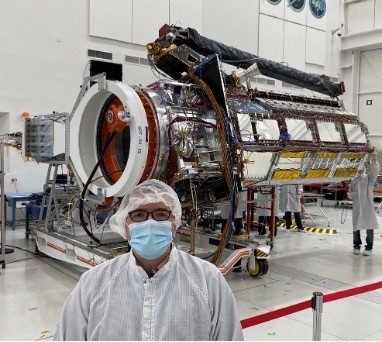GEOG Seminar 2/16: "SAR Remote Sensing for Ecosystems and Agriculture: A background with new developments and trends" by Dr. Paul Siqueira
Join us for our weekly seminar this Thursday, February 16th from 3:45-5pm in River Road RM 325 or via Zoom! Dr. Paul Siqueira, the Ecosystem Science Lead for NISAR mission, will be presenting "SAR Remote Sensing for Ecosystems and Agriculture: A background with new developments and trends."
Speaker Bio:
Dr. Paul Siqueira is Professor of Electrical and Computer Engineering at the University of Massachusetts in Amherst and is co-Director of the University’s Microwave Remote Sensing Laboratory (MIRSL). In previous appointments, he has been a senior engineer at NASA’s Jet Laboratory, a visiting scientist for the European Commission in Ispra, Italy, and a Bullard Fellow at Harvard’s forest research station in Massachusetts. His work within MIRSL is in the design, development and use of microwave remote sensing instruments for earth science applications. While at UMass, Professor Siqueira has developed airborne Interferometric SAR’s that work at S-, Ku- and Ka-band frequencies, which are used for studying the remote sensing signatures of vegetation, soils, and snow.
Professor Siqueira is the Ecosystems Science Lead for NISAR, a joint NASA/ISRO L- and S-band SAR mission due to be launched in January 2024. He is also the PI for Snow Water Equivalent Wide-swath Interferometer and scatterometer (known as SNOWWI) which is an airborne instrument and satellite constellation concept that is being developed for NASA-ESTO’s Instrument Incubator Program. Professor Siqueira also serves as a co-investigator in NASA’s Carbon Monitoring Systems (CMS) and Arctic-Boreal Vulnerability Experiment (ABoVE) programs.
Seminar Abstract:
The exciting new mission, NISAR, has been a joint effort between NASA and the Indian Space Research Organization (ISRO) for the better part of a decade. On January 25th 2023, the instrument formally passed its “pre-ship” review, and is now on its way to the Satish Dhawan Space Centre (SDSC) located on the southeastern coast of India in preparation for launch in January 2024. The NISAR mission is a two-frequency Synthetic Aperture Radar (L- and S-band) that will collect dual-polarized L-band data over most of the world’s land surfaces and cryosphere. Although data rate, thermal and observing constraints limit the amount of S-band and fully-polarimetric data that can be collected, certain regions over the midwestern US, India and NISAR calibration/validation sites will be collected at this 12-day repeat period as well.
Because of the ability of SAR to penetrate through cloud cover and to operate in both day- and night-time, its wall-to-wall mapping within its 250km swath at ~20 m resolution, the downlink data rate will be ~4.5 TBytes/day. As such, this amount of remote sensing data will present new challenges and opportunities to the Earth Science community. Some of these challenges will be related to how to effectively make use of this much data that will be incoming at a consistent pace over the lifetime of the mission. This will place a new emphasis on deploying algorithms into the cloud and developing algorithms that can make use of this new era of “big data”. The benefits will be that NISAR will be producing an unprecedented data set, both in terms of its temporal and global coverage. This will create new opportunities for creating algorithms that make best use of this time-series of data, and in many ways will change the way that SAR algorithms will be written. Such is the case already with ESA’s Sentinel-1 C-band satellites, and will evolve to the next stage with NISAR.
Zoom Meeting: Please email pbasak@umd.edu for Zoom meeting information.


